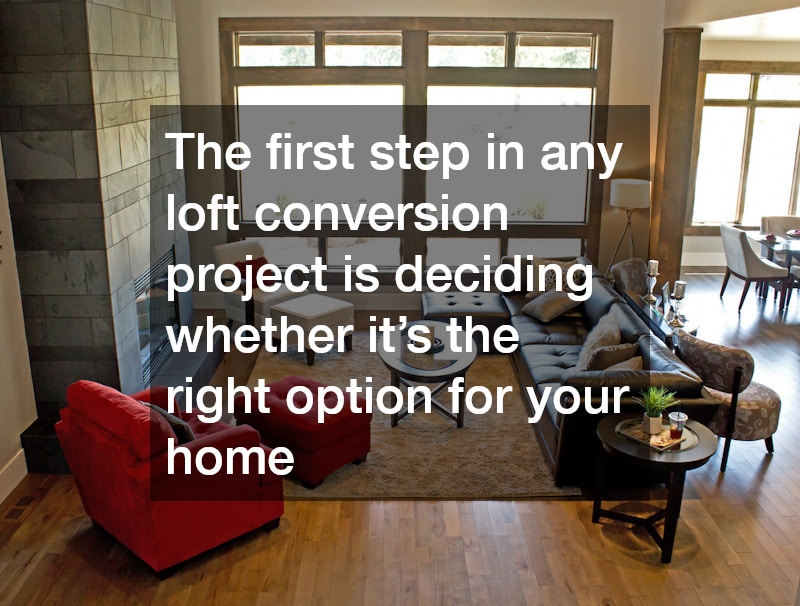A loft conversion is one of the most effective ways to add both space and value to your home. Whether you need an extra bedroom, a home office, or simply more storage, converting your loft offers a flexible and cost-efficient solution. However, undertaking such a project can feel overwhelming if you’re unfamiliar with the process. This loft conversion guide is designed to walk you through everything you need to know to transform your unused loft into a functional living space.
Is a Loft Conversion Right for You?
The first step in any loft conversion project is deciding whether it’s the right option for your home. Not all lofts are suitable for conversion, and certain factors can affect whether the project is feasible.
One of the most important considerations is head height. For a loft conversion to be practical, the space should have at least 2.2 meters of headroom from the floor to the highest point in the ceiling. If your loft doesn’t meet this requirement, you may need to explore alternative solutions, such as lowering the ceiling in the rooms below or raising the roof, although these options can add significant costs.
Another factor to consider is the layout of your home and how the loft will integrate with the rest of your property. If your loft has easy access via a staircase, it may be a straightforward project. However, if access is limited, you may need to plan for the installation of a new staircase, which will impact both cost and available space in your home.
Planning and Permissions
Once you’ve determined that a loft conversion is possible, the next step is planning. In most cases, you won’t need full planning permission for a loft conversion, as it’s often considered a permitted development under UK regulations. However, it’s essential to check local building codes and planning rules, especially if you live in a conservation area or a listed building. Even if planning permission isn’t required, you will still need to comply with building regulations, which are designed to ensure the safety and structural integrity of the conversion.
Building regulations cover various aspects of the project, including structural stability, fire safety, insulation, and ventilation. It’s a good idea to hire a professional architect or builder who understands these regulations and can ensure your loft conversion meets all the necessary requirements. Your local council will also need to inspect the work at various stages to confirm compliance with building regulations.
Types of Loft Conversions
There are several types of loft conversions, and the right one for you will depend on your budget, space, and design preferences. A basic loft conversion involves transforming the existing space with minimal structural alterations, typically adding windows and insulation. This is often the most affordable option but may not provide as much additional space as more extensive conversions.
A dormer loft conversion involves extending the roof to create more usable space. This type of conversion adds headroom and allows for the installation of larger windows, making the room feel more spacious and brighter. Dormer conversions are a popular choice because they offer a good balance of added space and cost-effectiveness.
For homes with more substantial budgets, a mansard loft conversion is another option. This involves replacing one or both sides of the roof with a near-vertical structure, creating a large amount of additional space. Mansard conversions require more extensive construction work and are generally more expensive, but they can dramatically increase the size and usability of your loft.
Design Considerations
Once you’ve chosen the type of conversion that suits your needs, it’s time to think about the design. The most important element is how you intend to use the space. If you’re creating a bedroom, consider features such as built-in wardrobes or an en-suite bathroom to maximize functionality. For a home office, you might prioritize natural light and storage space for equipment and supplies. Your architect or designer can help you optimize the layout to make the best use of the space while ensuring that it meets your needs.
Lighting is another critical aspect of loft conversions. Skylights or roof windows can flood the space with natural light, making it feel open and inviting. Depending on your budget, you might also want to consider adding a balcony or roof terrace to create outdoor space and increase the property’s value.
Insulation and ventilation are also essential for a comfortable and energy-efficient loft conversion. Proper insulation will ensure that the space remains warm in the winter and cool in the summer, while ventilation will prevent dampness and condensation, keeping the room in good condition for years to come.
Costs and Budgeting
The cost of a loft conversion can vary widely depending on the size of the space, the type of conversion, and the materials used. Basic loft conversions can start from as little as £20,000, while more extensive projects, such as a mansard conversion, can exceed £60,000. It’s important to get quotes from multiple builders and contractors to ensure you’re getting a fair price for the work.
In addition to the cost of construction, you should also budget for professional fees, such as those for architects, structural engineers, and building regulation inspections. You may also need to factor in the cost of new furnishings, electrical work, plumbing, and decorating to complete the conversion.
Final Thoughts
A loft conversion is an excellent way to add space and value to your home, but it’s important to approach the project with careful planning and consideration. This loft conversion guide has covered the essential steps, from assessing the feasibility of your loft to understanding the different types of conversions and budgeting for the project. With the right planning, a loft conversion can be a rewarding investment that enhances both your home and your lifestyle.
.




